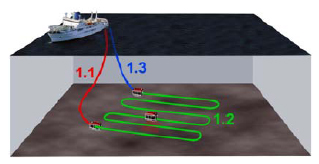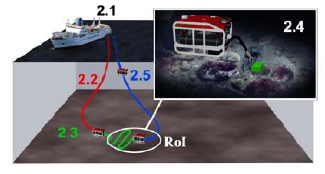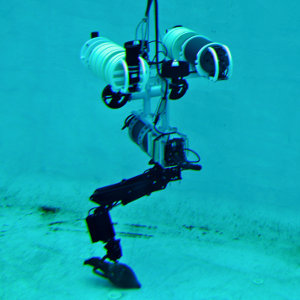VISUAL — Vision for submarine intervention using autonomous vehicles
VISUAL is a subproject of RAUVI, a Spanish national project that develops and improves the necessary technologies for autonomously performing an intervention mission in underwater environments. The approach can be summarized in two different steps: (1) survey and (2) intervention. Firstly, the I-AUV explores the region of interest, taking visual and acoustic data, synchronized with robot navigation. Then, the robot surfaces, and the information is downloaded to the base station, where a computer reconstruction of the explored region is built. By means of a specific human-robot interface to be developed, an operator identifies the object of interest and describes the task to perform. Next, the I-AUV robot navigates again to the region of interest, identifies the target object and performs the intervention task.
Therefore, the RAUVI project aims to design and develop an Underwater Autonomous Robot, able to perceive the environment by means of acoustic and optic sensors, and equipped with a robotic arm in order to autonomously perform simple intervention tasks.
Briefly, the main goals to achieve are the design and development of:
- A reconfigurable I-AUV for exploration and intervention tasks.
- The architecture in charge of robot navigation and I-AUV control, along with the planning and control mission system.
- A new hydraulic manipulator and its gripper.
- The control architecture and planning algorithms for manipulation.
- A multimodal 3D computer interface, including virtual and augmented reality techniques.
- New methods for visual motion estimation (mosaic building and dynamic positioning).
- Visual methods for target description and recognition.
Finally, several milestones are proposed, as experimental validation, in order to gradually take the I-AUV to realistic scenarios. Initially, a real prototype will be evaluated in water tank conditions, before the final evaluation in open sea conditions. RAUVI is a join project funded by the Spanish ministry of Science and Innovation. The project is coordinated by Prof. Pedro J. Sanz from the University Jaume I and involves teams from 3 universities UJI, UdG and UIB. The UdG team is responsible for designing and developing the reconfigurable AUV, the UJI team is responsible for the design and development of the robotic arm and the UIB team is responsible for the vision based navigation. The project starts in January 2009 and lasts for 3 years.

- 1. Survey Stage
- 1.1. Phase I: Launching
- 1.2. Phase II: Survey
- 1.3. Phase III: Recovery

- 2. Intervention Satge
- 2.1. Phase IV: Intervention Specification
- 2.2. Phase V: Launching
- 2.3. Phase VI: Approaching
- 2.4. Phase VII: Intervention
- 2.5. Phase VIII: Recovery
Here you can see an envisioned mission concept video (first simulation results):
Project Leader
Project Collaborators
Related Publications
-
New Solutions in Underwater Imaging and Vision Systems
Imaging Marine Life
-
A Monocular Mobile Robot Reactive Navigation Approach Based on the Inverse Perspective Transformation
Robotica
-
Underwater SLAM with Robocentric Trajectory Using a Mechanically Scanned Imaging Sonar
International Conference on Intelligent Robotis and Systems (IROS)
-
Concurrent Visual Navigation and Localization using the Inverse Perspective Transformation
IET Electronic Letters
-
Combining Obstacle Avoidance with Robocentric Localization in a Reactive Visual Navigation Task
Proceedings of the International Conference on Industrial Technology (ICIT 2012)
-
Reconfigurable AUV for intervention missions: a case study on underwater object recovery
Intelligent Service Robotics
-
Imaging Systems for Advanced Underwater Vehicles
Journal Of Maritime Research
-
A New Approach for a Reconfigurable Autonomous Underwater Vehicle for Intervention
4rd Annual IEEE International Systems Conference
-
Scan-Based SLAM with Trajectory Correction in Underwater Environments
Proceedings of the IEEE/RSJ International Conference on Intelligent Robots and Systems (IROS)
-
Time Based Correspondences Using Sonar Scan Matching
IEEE International Conference on Emerging Technologies and Factory Automation (ETFA)
-
Range Extraction from Underwater Imaging Sonar Data
IEEE International Conference on Emerging Technologies and Factory Automation (ETFA)
-
A Measurement Model for Mobile Robot Localization using Underwater Acoustic Images
IEEE International Conference on Emerging Technologies and Factory Automation (ETFA)
-
A Trajectory Based Framework to Perform Underwater SLAM using Imaging Sonar Scans
IEEE International Conference on Emerging Technologies and Factory Automation (ETFA)
-
Underwater Scan Matching using a Mechanical Scanned Imaging Sonar
IFAC Symposium on Intelligent Autonomous Vehicles (IAV)
-
Visual Localization using Ground Points
Artificial Intelligence Research and Development
-
Towards Monocular Localization Using Ground Points
Proceedings of IEEE International Conference on Emerging Technologies and Factory Automation (ETFA)
-
A Visual Navigation Strategy Based on Inverse Perspective Transformation
Robot Vision
-
Building a Qualitative Local Occupancy Grid in a new Vision-based Reactive Navigation Strategy for Mobile Robots
IEEE International Conference on Emerging Technologies and Factory Automation (ETFA)
-
A novel Vision-Based Reactive Navigation Strategy Based on Inverse Perspective Transformation
IEEE/IFAC International Conference on Informatics in Control, Automation and Robotics (ICINCO)
-
Recent Progress in the RAUVI Project: A Reconfigurable Autonomous Underwater Vehicle for Intervention
International Symposium ELMAR-2010
-
Experimental Assessment of Different Feature Tracking Strategies for an IPT-based Navigation Task
IFAC Symposium on Intelligent Autonomous Vehicles (IAV)
-
A Novel Inverse Perspective Transformation-based Reactive Navigation Strategy
European Conference on Mobile Robots (ECMR)







